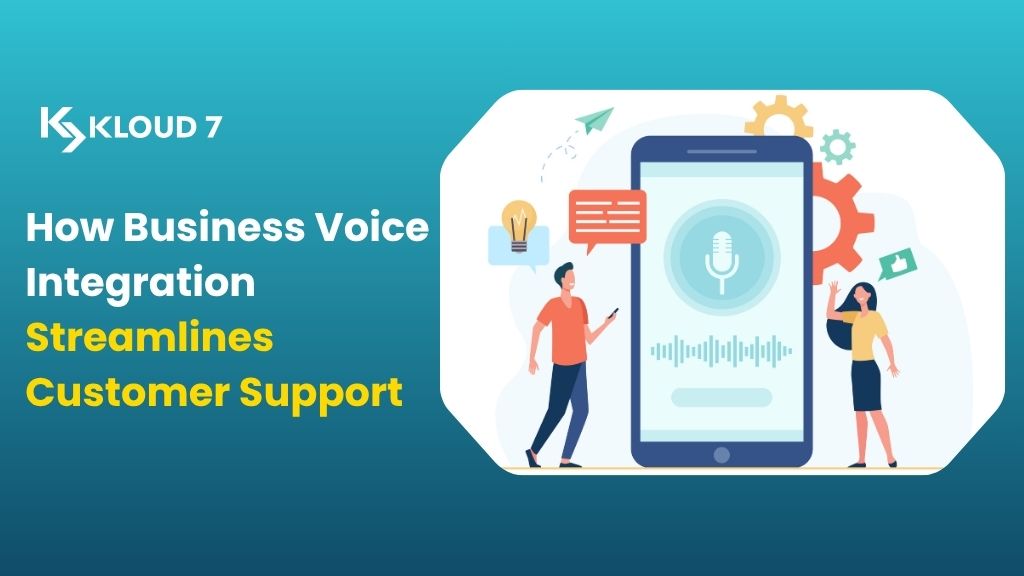Every business depends on how quickly and effectively it can communicate with customers. When a company’s phone systems, CRMs, and support tools work in isolation, it often leads to missed calls, delayed responses, and frustrated clients. That’s where business voice integration comes in.
It connects your communication channels, calls, customer records, and cloud tools into one functional ecosystem. Within weeks of using it, many teams start noticing smoother coordination, fewer manual tasks, and better service continuity. It’s not magic, just smart system design, powered by VoIP support systems, CRM integration, and cloud voice integrations, that keeps every touchpoint in sync.
What Is Business Voice Integration?
Business voice integration means connecting your phone or VoIP systems to the software and tools your business already uses, such as CRM, helpdesk platforms, or call center dashboards. Instead of juggling multiple tabs or manually logging calls, agents get a single view of customer activity. Every call, email, and chat appears in one place.
This helps both customer-facing and internal teams handle queries faster and maintain consistent communication. Whether through automated call routing or live caller ID synced with CRM data, integrated voice systems make every interaction more informed and personal.
For companies interested in advanced communication tools, Kloud7’s Business Voice Services offer scalable VoIP and cloud integration solutions built for efficiency.
How It Works
| Component | Function | Benefit |
| VoIP Support Systems | Converts voice into data for cloud-based calling | Reduces hardware cost, supports remote work |
| CRM Integration | Connects call data with customer profiles | Enables personalized service |
| Call Center Solutions | Manage inbound/outbound communication | Improves agent efficiency |
| Cloud Voice Integrations | Host systems online | Scalable, flexible, and location-independent |
The combination of these tools eliminates the gap between voice and data. Instead of switching between devices or software, employees interact through a unified communication system.
The Role of Business Voice Integration in Customer Support
Customer support is often the most affected by disjointed communication tools. Agents have to answer calls, update CRMs, track issues, and send follow-ups often across multiple systems. Business voice integration changes that dynamic.
1. Centralized Information
Agents can see caller history, previous tickets, and notes as soon as the call starts. There’s no need to ask customers to repeat their story. Integrated systems automatically display this data from the CRM, saving time and improving satisfaction.
2. Real-Time Collaboration
Integrated voice platforms allow teams to share notes, transfer calls intelligently, and even monitor performance in real time. For example, a sales call can easily shift to support without restarting the process if needed. Tools like K7 Connect enable businesses to stay connected with customers and teams through unified communication technology.
3. Improved Call Routing and Response Times
Using smart routing tools, calls are directed to the appropriate department based on customer needs. Cloud voice integrations handle this automatically, reducing missed calls and ensuring every query reaches the right expert.
4. Tracking and Analytics
Voice integration provides management with a complete picture of customer interaction history. Call duration, frequency, and satisfaction scores can all be tracked. Over time, this data helps identify trends such as when customers are most likely to call and which issues take longer to resolve.
5. Supporting Remote and Hybrid Teams
Modern teams often work from different locations. Cloud-based systems make it easy for remote agents to stay connected, manage calls, and securely access CRM data. It’s one of the key reasons VoIP support systems and cloud voice integrations have become the foundation of modern customer service. Managed Network Solutions ensures consistent connectivity and call quality across all offices and remote setups.
Benefits of Business Voice Integration
Business voice integration isn’t just about convenience it creates measurable results.
- Better Customer Experience: Fewer call transfers, shorter hold times, and personalized responses.
- Operational Efficiency: Automation handles repetitive tasks, such as logging calls and tracking follow-ups.
- Scalability: Cloud systems grow with your team and adapt as customer volume changes.
- Data Accuracy: Automatic data syncing keeps CRMs up to date without manual input.
- Reduced Costs: Fewer tools and maintenance overhead, since most systems run on a unified cloud infrastructure.
Integrated solutions supported by Managed IT Services keep your communication tools secure and optimized, allowing your teams to focus on what matters to your customers.
Integrating Voice with CRM and Call Center Solutions
This is where the technical part meets the human side of business. Integrating voice with your CRM system and call center solutions means your phone data isn’t just floating around it’s connected to your entire customer journey.
When a call comes in, the CRM automatically displays who’s calling, their purchase history, and any previous issues. After the call, notes or recordings are logged without effort.
For call centers, this integration means agents spend more time solving problems and less time typing. Supervisors can monitor real-time analytics and adjust staffing or scripts on the fly.
Common Integrations
- Salesforce, HubSpot, or Zoho CRM for contact management
- VoIP providers like Kloud7 for cloud-based calling
- Ticketing platforms like Zendesk for customer service tracking
To learn more about modern voice architecture and business connectivity, you can check Cisco’s official guide on VoIP and unified communications.
How to Implement Business Voice Integration
Setting up integration isn’t complicated, but it requires a structured approach.
- Assess your current communication tools – Check compatibility between your VoIP system and CRM.
- Choose integration software or APIs – Many providers offer prebuilt integrations for common CRMs.
- Migrate data carefully – Ensure customer records sync correctly between systems.
- Train your team – Teach employees how to use integrated dashboards efficiently.
- Monitor performance – Use analytics to measure impact on response time and satisfaction rates.
While large enterprises may use custom solutions, even small and mid-sized businesses can start with simple VoIP-CRM integrations to achieve big efficiency gains.
FAQs
1. What is business voice integration?
It’s the process of connecting communication systems like VoIP phones, CRMs, and cloud tools to create a unified customer support workflow.
2. How does CRM integration improve voice communication?
CRM integration provides instant access to customer history, helping agents personalize interactions and respond more effectively.
3. Can business voice integration work with existing call center solutions?
Yes. Most modern call center solutions support API-based integration with voice and CRM systems, improving performance and tracking.
4. What are the main benefits of cloud voice integrations?
They provide scalability, lower costs, and flexibility, allowing businesses to manage calls and data from anywhere.
5. Are VoIP support systems required for business voice integration?
Not always, but VoIP systems make integration easier by supporting digital call management, remote access, and automated routing.
Conclusion
Business voice integration connects communication and data to make customer support smarter, faster, and more human. Whether you’re managing a small helpdesk or a global call center, these systems reduce friction between teams and customers. They create consistency; every conversation starts with context. If your business still switches between apps or struggles to track customer calls, it’s time to simplify communication. Visit Kloud7 to learn how our business voice, managed IT, and network solutions can help your organization stay connected anytime, anywhere.




